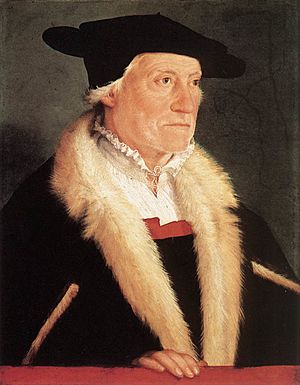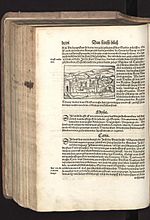Sebastian Münster facts for kids

Sebastian Münster (born January 20, 1488 – died May 26, 1552) was a very important German cartographer and cosmographer. A cartographer is someone who makes maps, and a cosmographer studies and describes the universe, including the Earth. He was also a Christian Hebraist, meaning he was a Christian scholar who studied the Hebrew language and Jewish texts. He taught as a professor at the University of Basel.
Münster is best known for his amazing world map and book called Cosmographia. This book was very popular and sold many copies, going through 24 different editions! Many artists created woodcuts (prints made from carved wood blocks) based on his work, which helped spread its influence far and wide.
Contents
Life of Sebastian Münster
Sebastian Münster was born in Ingelheim, a town near Mainz, Germany. His parents and grandparents were farmers.
In 1505, when he was about 17, he joined the Franciscan order, a religious group. Four years later, he went to a monastery where he studied for five years with a teacher named Konrad Pelikan. Münster finished his studies at the University of Tübingen in 1518. His main professor there was Johannes Stöffler.
In 1529, he left the Franciscan order to join the Lutheran Church. This allowed him to become a professor at the University of Basel. He had been interested in Lutheran ideas for a long time. As a monk, he had faced difficulties during the German Peasants' War.
His Work with Languages
As a professor, Münster taught Hebrew. He was a student of Elias Levita, another famous Hebrew scholar. Münster worked on editing the Hebrew Bible (which is the Old Testament for Christians). He published it in two large books in Basel between 1534 and 1535. This edition included a Latin translation and many notes. He was the first German scholar to create his own edition of the Hebrew Bible.
He also wrote several books on Hebrew grammar. In fact, he was the first person to create a grammar book for the Chaldaic language (a language related to Hebrew) in 1527. He also created dictionaries, including a Chaldaic dictionary in 1527 and a dictionary for Latin, Greek, and Hebrew in 1530.
Maps and World Descriptions
Münster created a map of Europe called Mappa Europae in 1536. In 1537, he published a Hebrew translation of the Gospel of Matthew (a book from the New Testament). He got this translation from Spanish Conversos, who were Jews who had converted to Christianity.
In 1540, he published a Latin version of Ptolemy's Geographia, an ancient book about geography, with many illustrations. Later editions, like the one from 1550, included pictures of cities, portraits of people, and different costumes. These editions, printed in Germany, are highly valued today.
He also wrote other books, such as Horologiographia (a book about how to build sundials, 1531) and Organum Uranicum (a book about how planets move, 1536).
The Famous Cosmographia
Sebastian Münster's most famous work was his Cosmographia, published in 1544. This was the first description of the world written in the German language. It was incredibly popular and was printed in many different languages, including Latin, French, Italian, English, and even Czech.
The Cosmographia was one of the most successful books of the 16th century. It had 24 editions over 100 years! Its success was partly because of the beautiful woodcut illustrations. Some of these were made by famous artists like Hans Holbein the Younger. The book was also important because it was the first to include separate maps for each of the four continents known at that time: America, Africa, Asia, and Europe. It played a huge role in bringing geography back to life in Europe during the 1500s. The last German edition was published in 1628, long after Münster's death.
Later Works and Death
Münster also translated the Hebrew Bible, which was published in two volumes in 1546. The first volume contained books from Genesis to 2 Kings. The second volume included the Prophets, Psalms, and other important books.
His book Rudimenta Mathematica was published in Basel in 1551.
Sebastian Münster died in Basel in 1552 from the Black Death, a terrible plague. His tombstone describes him as the Ezra (a famous Jewish scribe) and the Strabo (a famous Greek geographer) of the German people.
Gallery
Many artworks show Sebastian Münster, including paintings and prints. He was even featured on the 100-DM banknote used in Germany from 1962 to 1991!
-
Old 100 DM banknote, 1962–1991, showing Münster.
See also
 In Spanish: Sebastian Münster para niños
In Spanish: Sebastian Münster para niños











